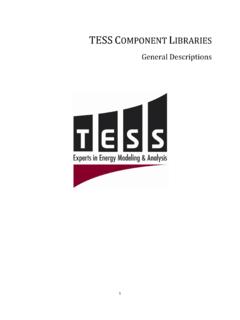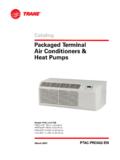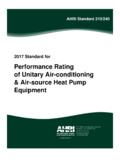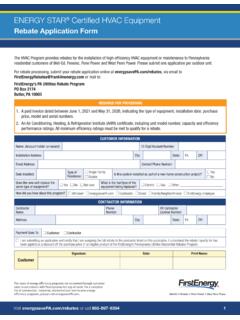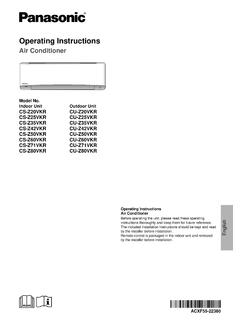Transcription of Standard Component Library Overview - TRNSYS
1 TRNSYS 18 a TRaNs i e n t SYs t e m Si m u l a t i o n p r o g r a m V o l u m e 3 S t a n d a r d C o m p o n e n t L i b r a r y O v e r v i e w Solar Energy Laboratory, Univ. of Wisconsin-Madison TRANSSOLAR Energietechnik GmbH CSTB Centre Scientifique et Technique du B timent TESS Thermal Energy Systems Specialists TRNSYS 18 Standard Component Library Overview 3 2 About This Manual The information presented in this manual is intended to provide a quick Overview of the Standard Component Library in TRNSYS 18. This manual is not intended to provide detailed reference information about the TRNSYS simulation software and its utility programs. More details can be found in other parts of the TRNSYS documentation set.
2 The latest version of this manual is always available for registered users on the TRNSYS website (see here below). Revision history 2004-09 For TRNSYS 2005-02 For TRNSYS 2006-01 For TRNSYS 2009-11 For TRNSYS 2010-04 For TRNSYS 2010-08 For TRNSYS 2011-11 For TRNSYS 2014-05 For TRNSYS 2017-03 For TRNSYS Where to find more information Further information about the program and its availability can be obtained from the TRNSYS website or from the TRNSYS coordinator: TRNSYS Coordinator Thermal Energy System Specialists, LLC 22 North Carroll Street suite 370 Madison, WI 53703 Email: TRNSYS website: Notice This report was prepared as an account of work partially sponsored by the United States Government.
3 Neither the United States or the United States Department of Energy, nor any of their employees, nor any of their contractors, subcontractors, or employees, including but not limited to the University of Wisconsin Solar Energy Laboratory, makes any warranty, expressed or implied, or assumes any liability or responsibility for the accuracy, completeness or usefulness of any information, apparatus, product or process disclosed, or represents that its use would not infringe privately owned rights. 2017 by the Solar Energy Laboratory, University of Wisconsin-Madison The software described in this document is furnished under a license agreement. This manual and the software may be used or copied only under the terms of the license agreement.
4 Except as permitted by any such license, no part of this manual may be copied or reproduced in any form or by any means without prior written consent from the Solar Energy Laboratory, University of Wisconsin-Madison. TRNSYS 18 Standard Component Library Overview 3 3 TRNSYS Contributors Klein Beckman Mitchell Duffie Duffie Freeman Mitchell Braun Evans Kummer Urban A. Fiksel Thornton Blair Williams Bradley McDowell M. Kummert Arias Duffy Additional contributors who developed components that have been included in the Standard Library are listed in Volume 4. Contributors to the building model (Type 56) and its interface (TRNB uild) are listed in Volume 5. Contributors to the TRNSYS Simulation Studio are listed in Volume 2.
5 TRNSYS 18 Standard Component Library Overview 3 4 TABLE OF CONTENTS 3. Standard Component Library Overview 3 8 Introduction 3 8 Main categories of components 3 8 Subcategories of components 3 9 Overview of available components in each category 3 14 Controllers 3 14 5-Stage Room Thermostat 3 14 Basic Aquastat 3 14 Basic Humidity Control 3 15 Delayed Inputs 3 15 Differential Controller w_ Hysteresis 3 15 Iterative Feedback Controller 3 17 Microprocessor Controller 3 17 PID Controller 3 17 Simple Thermostat 3 17 Tempering Valve Control 3 18 Electrical 3 18 Batteries 3 18 Busbar 3 20 Diesel Engine (DEGS) 3 20 MiniGrid Controller 3 21 Photovoltaic Panels 3 21 Power Conditioning 3 23 Regulators and Inverters 3 23 Wind Turbines 3 25 Ground Coupling 3 25 Slab on Grade 3 25 HVAC 3 25 Absorption Chiller (Hot-Water Fired, Single Effect)
6 3 25 Air Heater 3 26 Air-Cooled Chiller 3 26 Air-Source Heat Pump 3 26 Boiler 3 27 TRNSYS 18 Standard Component Library Overview 3 5 Conditioning Equipment 3 27 Cooling Coils 3 28 Cooling Towers 3 29 DX Coil 3 32 Fan Coil 3 32 Fluid Heater 3 32 Furnace 3 33 Heating Coil 3 33 packaged Terminal Air Conditioner 3 33 Part Load Performance 3 34 split System AC 3 34 VAV Air Handlers 3 34 Water-Cooled Chiller 3 35 Water-Source Heat Pump 3 35 Hydrogen Systems 3 36 Compressed Gas Storage 3 36 Compressor 3 36 Controllers 3 36 Electrolyzer 3 37 Fuel Cells 3 38 Hydronics 3 42 Controlled Flow Mixer 3 42 Duct 3 42 Fan 3 43 Flow Diverter 3 43 Heat Exchanger 3 44 Pipe 3 46 Pumps 3 46 Tee-Piece Flow Mixer 3 46 Temperature Controlled Flow Diverter 3 47 Loads and Structures 3 47 Infiltration 3 47 Multi-Zone Building 3 48 Multi-Zone Building with Internal Solver Parameters 3 48 Overhang and Wingwall Shading 3 49 Simple Natural Ventilation 3 49 Single Zone Models 3 49 TRNSYS 18 Standard Component Library Overview 3 6 Thermal Storage Wall 3 50 Obsolete 3 51 Output 3 51 Online Plotter 3 51 Printegrator 3 52 Printer 3 53 Scope 3 55 Simulation Summary 3 55 TRNSYS Plugin for SketchUp Printer 3 56 Physical Phenomena 3 56 Collector Array Shading 3 56 Convection Coefficient Calculation 3 57 Lumped Capacitance Model 3 58 Radiation Processors 3 58 Shading Masks 3 60 Simple Ground Temperature Model 3 61 Sky Temperature 3
7 61 Thermodynamic Properties 3 62 Weather Generators 3 64 Solar Thermal Collectors 3 65 CPC Collector 3 65 Evacuated Tube Collector 3 66 Performance Map Collector 3 66 PV-Thermal Collectors 3 68 Quadratic Efficiency Collector 3 70 Theoretical Flat-Plate Collector 3 72 Thermosyphon Collector with Integral Storage 3 72 Thermal Storage 3 73 Constant Volume Liquid Storage 3 73 Plug-Flow Tank 3 73 Rock Bed Storage 3 74 Simple Electric Heated Liquid Storage 3 74 Simple Gas Heated Liquid Storage 3 74 Variable Volume Tank 3 75 Utility 3 75 Calling External Programs 3 75 Data Readers 3 77 Differentiation 3 79 TRNSYS 18 Standard Component Library Overview 3 7 EN 15251-2007 Floating Mean Temperature 3 80 Forcing Function Sequencers 3 81 Forcing Functions 3 81 Holiday Calculator 3 83 Integrators 3 84 Interpolation 3 85 Moving Average 3 86 Simulation Control 3 86 Time Values 3 86 Unit Conversion Routine 3 86 Utility Rate Schedule Processors 3 87 Weather Data Reading and Processing 3 87 Standard Format 3 87 User Format 3 89 TRNSYS 18 Standard Component Library Overview 3 8 3.
8 Standard Component Library Overview Introduction About one hundred models are included in the Standard TRNSYS Library . This document is intended to give users a quick Overview of the available components. It should be used together with the Volume 4: Mathematical Reference, which gives the mathematical algorithms of all models included in the Standard Library of components. This volume is organized in 3 main sections that explore the tree of available components from the trunk to the smaller branches in order to allow users to quickly find the Component they need. Note that Simulation Studio users are invited to use the "Direct Access Tool" in the Studio, which will give them access to a "live" version of the Component tree. Volume 3 is organized according to the user interface of each Component ("proformas" in the Simulation Studio), while Volume 4 is organized according to the models on which components are based.
9 Models are known as types and correspond to a Fortran file. The same model can (and often does) have different proformas associated with it. Example: The Flat-plate Solar collector model using a quadratic efficiency curve (Type 1) has 5 operating modes, which correspond to 5 proformas in the Studio. It has 5 entries in Volume 3. There are about 300 available proformas for about 100 Fortran routines. Main categories of components The Standard Component Library is organized in 14 categories: 1. Controllers This category contains various general purpose controllers and thermostats. 2. Electrical This category contains components that generate or store electricity and their accessories: solar photovoltaic (PV) systems. Wind Energy Conversion Systems (WECS, or wind turbines), Diesel engines, Power conversion systems, batteries.
10 3. Ground Coupling This category components for calculating the heat exchange between a building and the ground. 4. HVAC This category contains several auxiliary heating and cooling devices, including absorption cooling machines. 5. Hydrogen Systems TRNSYS 18 Standard Component Library Overview 3 9 Most components from the HYDROGEMS Library are in this category (some components have been moved to the "electrical" category). The HYDROGEMS Library provides models to simulate Hydrogen-based systems: fuel cells, electrolyzers, Hydrogen storage devices, etc. 6. Hydronics Fans, pumps, pipes, ducts and flow diverters or mixers can be found here 7. Loads and Structures This category includes Type 56, the multizone building model (see Volume 5) but also different single zone models of increasing complexity as well as some other components that are often integral to building simulations.
